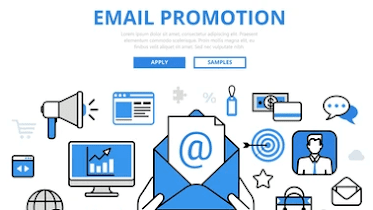Email marketing is a digital marketing strategy that involves sending marketing messages or advertisements to a group of people via email. It is meant to build relationships with potential customers or clients and to keep existing ones informed about new products, services, or promotions.
So , here we will discuss about what is an email marketing. So, don't waste your time continue to the reading.

What is an Email Marketing?
Email marketing can be an effective way for businesses to reach and engage with their target audience, as it allows them to deliver targeted messages directly to a large group of people. Email marketing can be used to promote products or services, build brand awareness, and drive sales or leads.
To use email marketing effectively, a business will typically build an email list of potential customers or clients, create email campaigns to send to that list, and track and analyze the results of those campaigns. This can help the business understand how effective email marketing efforts are and where to focus its efforts in the future. So, What is an Email marketing is actually like this and all about this strategy are given below.
Overall, email marketing is a valuable component of a comprehensive digital marketing strategy and can help businesses reach and engage with their target audience in a cost-effective and measurable way.
Types of Email Marketing
There are many types of email marketing, which are given below:
- Newsletters
- Promotional emails
- Transactional emails
- Relationship-building emails
1. Newsletters:
Newsletters are regular emails that contain information about a company, its products or services, and any special offers or promotions that is also a good strategy in SEO. They are typically sent on a regular basis, such as weekly or monthly, and are meant to keep subscribers informed and engaged.
Newsletters can be an effective way for businesses to keep their audience informed about new developments, products, or services. They can also be used to build brand awareness and drive traffic to a company's website or social media channels.

To create an effective newsletter, a business will typically:
- Determine the purpose and goals of the newsletter: This could include things like promoting a new product, sharing industry news, or building brand awareness.
- Choose a format and style: Newsletters can be formatted in a variety of ways, such as a traditional text-based email or a more visually-appealing design. The style should be consistent with the brand and the tone should be appropriate for the audience.
- Create content: The content of the newsletter should be relevant and engaging for the target audience. This could include things like articles, tips, case studies, or special offers.
- Design and layout: The layout and design of the newsletter should be visually appealing and easy to read. It should also include links to the company's website or social media channels.
- Schedule and send: The newsletter should be scheduled and sent at a time that is most likely to be received and read by the target audience.
Overall, newsletters can be a valuable part of an email marketing strategy and can help businesses stay connected with their audience and drive engagement.
2. Promotional emails
Promotional emails are emails that contain information about a special offer or promotion, such as a sale or discount. Promotional Marketing is a best reply to the "What is email marketing Strategy" question.They are typically sent to a large group of people in an effort to generate more sales or leads.
Promotional emails can be an effective way for businesses to drive traffic to their website or stores and increase sales. They can also be used to showcase new products or services, or to promote special events or seasonal promotions.
To create an effective promotional email, a business will typically:
- Determine the purpose and goals of the email: This could include things like promoting a sale or introducing a new product.
- Choose a target audience: The target audience for the email should be carefully selected based on factors such as demographics, interests, and past purchase history.
- Create a compelling subject line: The subject line is the first thing a recipient will see, so it should be attention-grabbing and relevant.
- Design the email: The email should be visually appealing and easy to read. It should also include a clear call to action, such as "Shop now" or "Learn more."
- Test and send: The email should be tested to ensure that it looks and functions correctly on different devices and email clients. It should then be sent at a time when it is most likely to be received and opened by the target audience.
Overall, promotional emails can be a valuable part of an email marketing strategy and can help businesses drive traffic and sales.

3. Transactional emails
Transactional emails are emails that are sent in response to a specific action taken by a customer or client, such as making a purchase or signing up for a service.It is also a best example of a question What is email marketing strategy. They are meant to provide information or confirmation about the action taken, and may include receipts, invoices, or other important information.
Transactional emails are typically automated and are triggered by a specific action taken by the recipient. They are not meant to be promotional in nature, but rather to provide information that is necessary or requested by the recipient.

Examples of transactional emails include:
- Order confirmation emails: These are sent after a customer has made a purchase and contain information about the order, such as the items purchased and the total cost.
- Shipping confirmation emails: These are sent after an order has been shipped and contain information about the tracking number and expected delivery date.
- Account creation emails: These are sent after a user has created a new account on a website or app and contain information about how to log in and access their account.
- Password reset emails: These are sent when a user has requested to reset their password and contain instructions on how to do so.
To create an effective transactional email, a business will typically:
- Determine the purpose and goals of the email: This could include things like providing confirmation of a purchase or delivering important information.
- Design the email: The email should be visually appealing and easy to read, with clear headings and formatting to help the recipient find the information they need quickly.
- Include relevant information: The email should include all necessary information, such as receipts, invoices, tracking numbers, or account login details.
- Test and send: The email should be tested to ensure that it looks and functions correctly on different devices and email clients. It should then be sent automatically in response to the specific action taken by the recipient.
Overall, transactional emails can be an important part of an email marketing strategy and can help businesses provide important information and confirmations to their customers or clients.
4. Relationship-building emails
Relationship-building emails are emails that are meant to strengthen the relationship between a company and its customers or clients. This is best marketing in Digital Marketing platform. They may contain personalization, such as the recipient's name or location, and may be more casual and conversational in tone.
Relationship-building emails can be used to nurture and maintain relationships with customers or clients and can help build brand loyalty. They may include content such as customer stories, tips or advice, or behind-the-scenes looks at the company.

To create an effective relationship-building email, a business will typically:
- Determine the purpose and goals of the email: This could include things like strengthening the relationship with the recipient or building brand loyalty.
- Choose a target audience: The target audience for the email should be carefully selected based on factors such as demographics, interests, and past purchase history.
- Personalize the email: The email should contain personalization such as the recipient's name or location to make it more relevant and engaging.
- Create engaging content: The content of the email should be interesting and valuable to the recipient. This could include customer stories, tips or advice, or behind-the-scenes looks at the company.
- Test and send: The email should be tested to ensure that it looks and functions correctly on different devices and email clients. It should then be sent at a time when it is most likely to be received and read by the target audience.
Overall, relationship-building emails can be a valuable part of an email marketing strategy and can help businesses build and maintain strong relationships with their customers or clients. So this is all about What is an Email marketing.